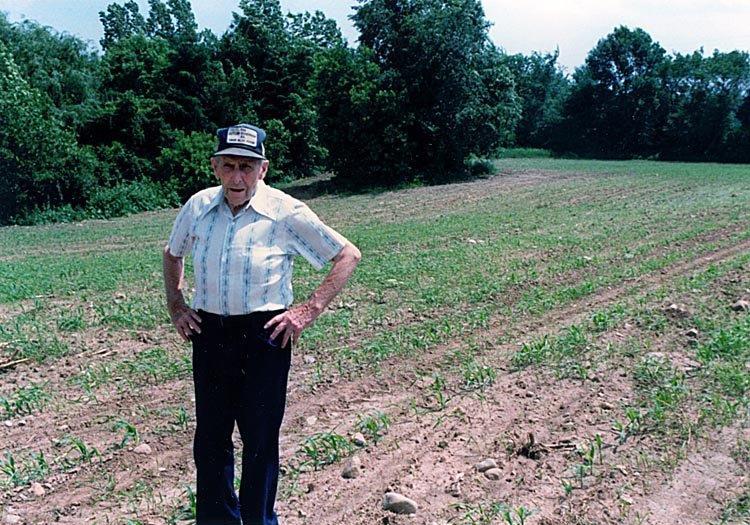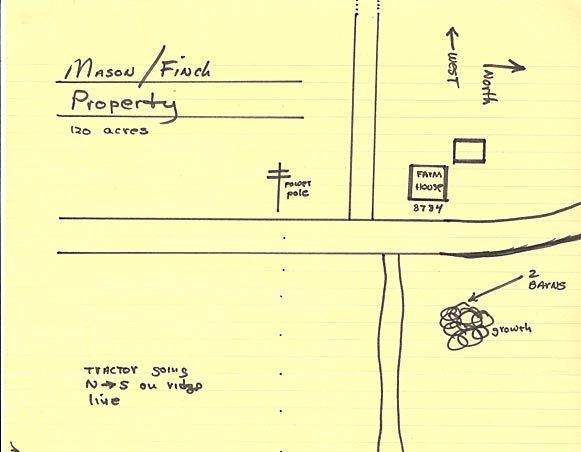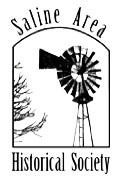Salt Mine
Harry Finch and the Salt Mine
By Bill Lavery
This interview took place June 9, 1986
Definitions of SALINE:
adj. 1. Of, relating to, or containing salt; salty;
n. 2. A quiet German farm town in Southeastern Michigan.
In 1986, Harry Finch lives beyond Frieda Schumaier and Curly Lueckhart on Macon Road. He is 90 years old and the father of two daughters still living. While he was employed by R & B Tool Company, Harry maintained the family homestead for years with 14 cows that he milked morning and evening, ran a few steers and a couple of dozen sheep. In 1966, Harry sold the land to a Mr. Mason and moved to Pleasant Lake Road until moving again to his present home about one mile south of the homestead.
His great grandfather bought the land in 1850. I believe Harry said there was a total of 36 acres straddling the road in that parcel. In 1865, his great grandfather sold 12 acres of the land to a group of speculators out of Saline, who hoped to mine the salt on the site by means of wells. The arrangement included a contingency that allowed for the return of the land to the great grandfather if the salt was not found or not mined.
When the speculators dug the well, two vertical holes were drilled to a depth which Harry later estimated at 200 - 225 feet. (This was the depth of a well effort by a neighbor across the Saline-Milan Road.) The well was worked for one or two years and then abandoned. The land, which had brought a price of $12,000 (sic), reverted to his great grandfather. After that, the land remained in the family for 4 generations.
Harry continued to farm the land each year. It wasn't until one day in the 1940s that his tractor wheel sunk deeply into the well, causing him no bit of trouble.
In time, Harry could see that there was yet some brine oozing out of the second casing. He thought back to what his grandfather had related to him about the working of the wellhead. The method involved running boiling water down one casing to the salt deposit, eventually building pressure and filling the void while dissolving the salt, which then rose in the second casing as a brine solution. This liquid version of the salt was then led to big metal pans where salt was gained in time, following evaporation of the water.
Before refilling the hole with dirt within a day or so, Harry invited a Boy Scout Cub Pack to view the well. It seems to me that Lyle Wahl and Bob Gross were members of one den that visited. The Cub leader was Mr. Ken Volz, Sr., who was associated with St. Pauls Church. After that visit, Harry filled the hole for fear of having adventurous children suffer a mishap.
Harrys grandfather had once tried to boil out some salt himself, but had never used it for any purpose. And while his dad may have also tried it, Harry never did, accepting the earlier findings of his ancestors. He did, however, have an offer of a local gentleman to jointly have a go at the well but then the fella was not the kind with whom he wanted to do business.
Site of Indian Salt Lick
Salines roots and very name come from serving as a source of salt to Indians who lived or passed through the area. The salt lick itself was just east of the river and 20 feet or so onto the land which in the old days had been more meadow, while now it is swampy. Harry thought that perhaps the City owned that property, which is located north of the DNR Fisheries. Originally, this property belonged to Mr. Barr as it was part of his farm.
The well site is north of the barns. Harry put up a sign identifying the salt well site before he sold the land in 1955 to Mr. Mason. Thereafter, the sign was taken down or lost, probably when the barns and outbuildings were removed in preparation for subdividing the land. Harry would have liked the City to purchase the property, so it could have been open to the public. However, the City wasn't interested.
Other salt well sites include one further west and another at the Ford Pond, as well as the site mentioned previously on Saline-Milan Road, across the river.
Harry mentioned that the Ypsilanti Normal School had bought some land in the same area but had given it up. He has a receipt that relates to the transaction, but was unable to find it the day of the interview. He mentioned that Mr. Herbert Bartlett had been in the process of writing up the Sauk Trail. Harry was aware of a plank road that ran up through the property from Dundee. There was a tool shed or other such building standing just south of the bridge by the Hoover (Universal Diecasting) Factory. When the road was opened or bypassed, the Finch family hauled the building off and adjoined it to the homestead.
The Tecumseh Trail passed through the property too, with the Chief himself having spent a night with Harry's great grandfather (according to family lore). Tecumseh slept with companions on the living room floor. (Note: Tecumseh lived from 1768-1813 so the facts are challenging.) According to Harry, Tecumseh was a "big shot Indian from Indiana".
The Indians used a slippery elm for making bows. Harry's family found this on the land. His parents had kept a big cigar box full of arrowheads found on the land.
Up the road on the east side of what is now Frieda Schumaier's property, there had been a house with a big, 8-foot wide chimney for cooking, behind which was an opening where Black runaway slaves are supposed to have stayed in the underground railroad system on the way to Canada.
On this note, the interview ended abruptly.
Additional Notes from June 1986
This interview took place June 9, 1986
Definitions of SALINE:
adj. 1. Of, relating to, or containing salt; salty;
n. 2. A quiet German farm town in Southeastern Michigan.
In 1986, Harry Finch lives beyond Frieda Schumaier and Curly Lueckhart on Macon Road. He is 90 years old and the father of two daughters still living. While he was employed by R & B Tool Company, Harry maintained the family homestead for years with 14 cows that he milked morning and evening, ran a few steers and a couple of dozen sheep. In 1966, Harry sold the land to a Mr. Mason and moved to Pleasant Lake Road until moving again to his present home about one mile south of the homestead.
His great grandfather bought the land in 1850. I believe Harry said there was a total of 36 acres straddling the road in that parcel. In 1865, his great grandfather sold 12 acres of the land to a group of speculators out of Saline, who hoped to mine the salt on the site by means of wells. The arrangement included a contingency that allowed for the return of the land to the great grandfather if the salt was not found or not mined.
When the speculators dug the well, two vertical holes were drilled to a depth which Harry later estimated at 200 - 225 feet. (This was the depth of a well effort by a neighbor across the Saline-Milan Road.) The well was worked for one or two years and then abandoned. The land, which had brought a price of $12,000 (sic), reverted to his great grandfather. After that, the land remained in the family for 4 generations.
Harry continued to farm the land each year. It wasn't until one day in the 1940s that his tractor wheel sunk deeply into the well, causing him no bit of trouble.
In time, Harry could see that there was yet some brine oozing out of the second casing. He thought back to what his grandfather had related to him about the working of the wellhead. The method involved running boiling water down one casing to the salt deposit, eventually building pressure and filling the void while dissolving the salt, which then rose in the second casing as a brine solution. This liquid version of the salt was then led to big metal pans where salt was gained in time, following evaporation of the water.
Before refilling the hole with dirt within a day or so, Harry invited a Boy Scout Cub Pack to view the well. It seems to me that Lyle Wahl and Bob Gross were members of one den that visited. The Cub leader was Mr. Ken Volz, Sr., who was associated with St. Pauls Church. After that visit, Harry filled the hole for fear of having adventurous children suffer a mishap.
Harrys grandfather had once tried to boil out some salt himself, but had never used it for any purpose. And while his dad may have also tried it, Harry never did, accepting the earlier findings of his ancestors. He did, however, have an offer of a local gentleman to jointly have a go at the well but then the fella was not the kind with whom he wanted to do business.
Site of Indian Salt Lick
Salines roots and very name come from serving as a source of salt to Indians who lived or passed through the area. The salt lick itself was just east of the river and 20 feet or so onto the land which in the old days had been more meadow, while now it is swampy. Harry thought that perhaps the City owned that property, which is located north of the DNR Fisheries. Originally, this property belonged to Mr. Barr as it was part of his farm.
The well site is north of the barns. Harry put up a sign identifying the salt well site before he sold the land in 1955 to Mr. Mason. Thereafter, the sign was taken down or lost, probably when the barns and outbuildings were removed in preparation for subdividing the land. Harry would have liked the City to purchase the property, so it could have been open to the public. However, the City wasn't interested.
Other salt well sites include one further west and another at the Ford Pond, as well as the site mentioned previously on Saline-Milan Road, across the river.
Harry mentioned that the Ypsilanti Normal School had bought some land in the same area but had given it up. He has a receipt that relates to the transaction, but was unable to find it the day of the interview. He mentioned that Mr. Herbert Bartlett had been in the process of writing up the Sauk Trail. Harry was aware of a plank road that ran up through the property from Dundee. There was a tool shed or other such building standing just south of the bridge by the Hoover (Universal Diecasting) Factory. When the road was opened or bypassed, the Finch family hauled the building off and adjoined it to the homestead.
The Tecumseh Trail passed through the property too, with the Chief himself having spent a night with Harry's great grandfather (according to family lore). Tecumseh slept with companions on the living room floor. (Note: Tecumseh lived from 1768-1813 so the facts are challenging.) According to Harry, Tecumseh was a "big shot Indian from Indiana".
The Indians used a slippery elm for making bows. Harry's family found this on the land. His parents had kept a big cigar box full of arrowheads found on the land.
Up the road on the east side of what is now Frieda Schumaier's property, there had been a house with a big, 8-foot wide chimney for cooking, behind which was an opening where Black runaway slaves are supposed to have stayed in the underground railroad system on the way to Canada.
On this note, the interview ended abruptly.
Additional Notes from June 1986
- Lyle Wahl and Bob Gross were members of the 8-10 kids in the Cub Pack den that visited the Finch hole.
- Ken Volz, Sr. was the den leader (St. Paul Church).
- Regarding the Salt well at the Ford Pond, Dr. Leidheiser's wife was leader of the den which visited the sites.
- Herb Bartlett was a local historian with knowledge about the Saline Springs and the Toll Road.
- Bessie Collins was well known as a local historian.
- Jim Levleit confirmed that the salt lick was on City property.

Harry Finch in 1986. Photo by Bill Lavery.






?Map showing location of the Saline, Michigan salt mine.
